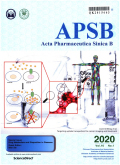- 钛学术文献服务平台 \
- 学术期刊 \
- 医药卫生期刊 \
- 药学期刊 \
- 药学学报(英文版)期刊 \
SMYD3—PARP16 axis accelerates unfolded protein response and mediates neointima formation
SMYD3—PARP16 axis accelerates unfolded protein response and mediates neointima formation
基本信息来源于合作网站,原文需代理用户跳转至来源网站获取
摘要:
Neointimal hyperplasia after vascular injury is a representative complication of restenosis.Endoplasmic reticulum(ER)stress-induced unfolded protein response(UPR)is involved in the pathogen-esis of vascular intimal hyperplasia.PARP16,a member of the poly(ADP-ribose)polymerases family,is correlated with the nuclear envelope and the ER.Here,we found that PERK and IRE1α are ADP-ribosylated by PARP16,and this might promote proliferation and migration of smooth muscle cells(SMCs)during the platelet-derived growth factor(PDGF)-BB stimulating.Using chromatin immunopre-cipitation coupled with deep sequencing(ChIP-seq)analysis,PARP16 was identified as a novel target gene for histone H3 lysine 4(H3K4)methyltransferase SMYD3,and SMYD3 could bind to the promoter of Parp16 and increased H3K4me3 level to activate its host gene's transcription,which causes UPR acti-vation and SMC proliferation.Moreover,knockdown either of PARP16 or SMYD3 impeded the ER stress and SMC proliferation.On the contrary,overexpression of PARP16 induced ER stress and SMC prolif-eration and migration.In vivo depletion of PARP16 attenuated injury-induced neointimal hyperplasia by mediating UPR activation and neointimal SMC proliferation.This study identified SMYD3-PARP16 is a novel signal axis in regulating UPR and neointimal hyperplasia,and targeting this axis has implications in preventing neointimal hyperplasia related diseases.

推荐文章
不同亚型人SMYD3启动子转录活性比较
SMYD3
启动子
转录活性
可诱导的shRNAs表达系统对HeLa细胞SMYD3基因表达的抑制
可诱导
shRNAs表达系统
SMYD3
抑制
SMYD3与细胞增殖相关性及其对细胞周期的影响
SMYD3
细胞增殖
相关性
细胞周期
NIH3T3细胞
SMYD3过表达对人肝内胆管癌细胞miR-124表达及细胞增殖的影响
HCCC-9810细胞
SET和MYND结构域含有蛋白3
miR-124
甲基化特异性PCR
细胞增殖
内容分析
关键词云
关键词热度
相关文献总数
(/次)
(/年)
引文网络
引文网络
二级参考文献 (0)
共引文献 (0)
参考文献 (37)
节点文献
引证文献 (0)
同被引文献 (0)
二级引证文献 (0)
2002(1)
- 参考文献(1)
- 二级参考文献(0)
2004(4)
- 参考文献(4)
- 二级参考文献(0)
2006(1)
- 参考文献(1)
- 二级参考文献(0)
2007(1)
- 参考文献(1)
- 二级参考文献(0)
2009(1)
- 参考文献(1)
- 二级参考文献(0)
2010(2)
- 参考文献(2)
- 二级参考文献(0)
2011(5)
- 参考文献(5)
- 二级参考文献(0)
2012(3)
- 参考文献(3)
- 二级参考文献(0)
2013(2)
- 参考文献(2)
- 二级参考文献(0)
2014(3)
- 参考文献(3)
- 二级参考文献(0)
2015(3)
- 参考文献(3)
- 二级参考文献(0)
2016(3)
- 参考文献(3)
- 二级参考文献(0)
2017(4)
- 参考文献(4)
- 二级参考文献(0)
2018(2)
- 参考文献(2)
- 二级参考文献(0)
2019(2)
- 参考文献(2)
- 二级参考文献(0)
2021(0)
- 参考文献(0)
- 二级参考文献(0)
- 引证文献(0)
- 二级引证文献(0)
引文网络交叉学科
相关学者/机构
期刊影响力
药学学报(英文版)
主办单位:
出版周期:
双月刊
ISSN:
2211-3835
CN:
10-1171/R
开本:
出版地:
北京市先农坛街1号
邮发代号:
创刊时间:
语种:
eng
出版文献量(篇)
688
总下载数(次)
0
总被引数(次)
1428
期刊文献
相关文献
推荐文献
- 期刊分类
- 期刊(年)
- 期刊(期)
- 期刊推荐

 免费查重
免费查重










